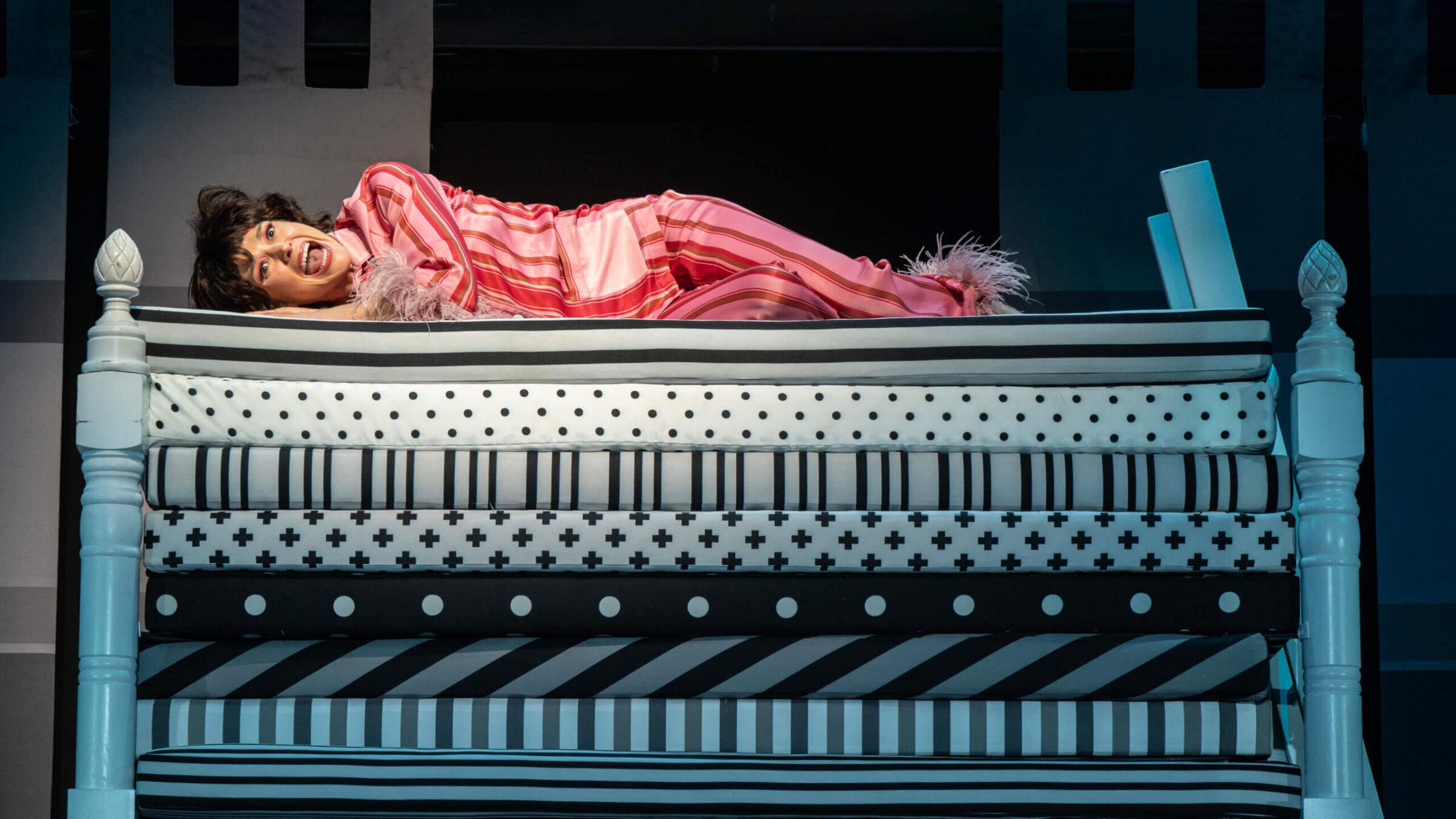‘Once Upon a Mattress’ started at a Jewish summer camp. Now it’s making a rowdy return to Broadway
A look into the socialist Jewish summer camp origins of the campy musical theater hit

Sutton Foster stars in Broadway’s revival of “Once Upon a Mattress,” which has a surprisingly Jewish backstory. Photo by Joan Marcus, courtesy of Vivacity Media
The crowd cackled at a pajama-clad Sutton Foster, playing the plucky Princess Winnifred, as she performed slapstick and splits on a stack of mattresses during a preview for Once Upon a Mattress, which opened Monday at the Hudson Theater on Broadway.
The show is a revival of the 1959 original, composed by Mary Rodgers and written by Marshall Barer, Jay Thompson and Dean Fuller. The new version, directed by Lear deBessonet, features an updated book by Amy Sherman-Palladino — perhaps best known in these pages for creating The Marvelous Mrs. Maisel — that preserves the physical comedy and spunk of the original while updating the script to be more modern and gender-inclusive.
But many moons ago, before this musical came to dazzle critics and dominate high school drama departments nationwide, Once Upon a Mattress got its start at Camp Tamiment: an adult musical theater summer camp with ties to the heavily Jewish socialist labor movement.
With roots in a distinctly twentieth-century Jewish-American culture, Once Upon a Mattress might be the most Yiddishkeit show on Broadway this season. (And not just because it’s about someone trying to shlof!)
A summer getaway with serious talent
Camp Tamiment started out in the 1920s in the Poconos Mountains in Pennsylvania as a summer campus of the Rand School of Social Science, a socialist school for union workers and other left-wing activists.
“Don’t think theater initially. It was for workers,” said Martha LoMonaco, a historian and director of the theater program at Fairfield University. She wrote an entire book about Camp Tamiment that stemmed from her Ph.D.
LoMonaco explained that the camp catered to New York socialists eager for both a political education and an escape from the city. That meant Camp Tamiment attracted many educated Eastern European Jewish immigrants steeped in Marxist thought.
“Most, if not 100%, of the young people who went to this camp were Jewish,” said LoMonaco. “And quite frankly, they were there to look for life partners!”
The Tamiment Playhouse, the camp’s theater venue, was first built to entertain adult camp patrons after a long day of playing tennis and swimming in the lake. By the end of the decade, the camp started bringing in professional artists to spearhead its productions.
Director Max Liebman pioneered the model of weekly Saturday night musical revues at the camp in the 1930s. His later success as a showrunner of the sketch comedy television series Your Show of Shows helped cement Tamiment’s reputation as an artistic hub. By the ’50s, the camp evolved into a well-known boot camp for Broadway-bound stars.
“If you wanted to hone your skills as a new, up-and-coming writer, actor, singer, director, choreographer, composer — you went to Tamiment,” said LoMonaco. Notable alumni that emerged from the camp’s cocoon include Neil Simon, Sylvia Fine and Broadway’s original Winnifred, Carol Burnett.
Mary Rodgers visited Camp Tamiment with her three children in the summer of 1958 at the advice of her writing partner, Marshall Barer. That summer, she helped create the play that went on to become one of the camp’s greatest exports.
A script with plenty of shtick
In her posthumously published collected memoirs, Shy, Rodgers describes the process of writing Mattress inside the “creative incubator” that was Camp Tamiment.
As Rodgers told New York Times theater critic Jesse Green, Barer had been meaning to write a musical adaptation of the Hans Christian-Anderson story, “A Princess and the Pea.” Tamiment, by then more of a resort, was the perfect place to try out their “pea musical” on a new audience.
The plot stays near the original fairy tale, but with the physical comedy dialed way up. When Prince Dauntless falls in love with the swamp kingdom’s Princess Winnifred, his disapproving mother Queen Aggravain poses a test: She places a pea on the bottom of Winnifred’s mattress before bedtime, since only a true princess would be delicate enough for the lump to interrupt her sleep.
Rodgers, Barer and team had only 10 days to devise a full-length show, and they had the extra challenge of accommodating all nine leading players that summer into the cast.
Barer invented new roles like the Wizard and Jester to accommodate the need for more major roles. The reason the show features a mute, pantomiming King? Because the camp’s best comic that summer, Milt Kamon, struggled to memorize lines.
“A big part of writing American musical theater was learning how to write for stars,” explained Jeffrey Sweet, a theater journalist and historian who also reported on Tamiment. Learning to write for specific actors and time constraints made the camp excellent training for up-and-coming creatives, he explained.
Rodgers herself was raised in a secular Jewish family and the show was written for the camp’s predominantly Jewish audience. But Sweet said that there is also another way in which Once Upon a Mattress is a quintessentially Jewish-American musical.
“There’s a strong theme of anti-authoritarianism in the show,” said Sweet. “Queen Aggravain certainly represents unreasonable dictatorial authority,” he explained, whereas “the most wildly comic and boisterous character is Winnifred. And to some degree she comes into this repressed society and liberates everybody.”
According to Sweet, this format has shown up in classic Broadway musicals like Mame, The Sound of Music and Carousel, all of which were written or composed by Jews. These stories use the idea of an “outsider” character coming into a closed-off community and introducing exciting new ideas — mirroring the experiences of many Jewish immigrants coming to America.
“Jewish liberalism is awfully important in musical theater,” he said.
A revival to kvell over

Back at the preview at the Hudson Theater, a mud-splattered Winnifred pulled a stuffed raccoon out of her hair. In a later scene, Winnifred slapped Prince Dauntless (Michael Urie) on the bottom and he cried, “Hey, that’s my tush!”
Retired English teacher Patricia Yost, 67, came all the way from Philadelphia to catch the preview with her husband and friend. She said she could not stop laughing in her balcony seat.
“My first show at college was actually Mattress,” said Yost, who starred as Winnifred her freshman year. “Winnifred is a wonderful part to play. You can be wild and crazy. It’s the true essence of musical comedy,” she said.
In her view, the Broadway revival “surpassed all expectations.” She especially loved the chemistry between the actors and the inclusive, multicultural cast.
“When I learned about its origins, I could definitely understand why it would be at a Jewish camp,” Yost said.
“They played upon the stereotype of the Jewish mother,” she explained, referring to Ana Grastayer’s performance as the overbearing Queen Aggravain. The queen disapproves of even Sutton Foster’s Winnifred marrying her son. (I mean … Sutton Foster!)
Yost said the story, regardless of where it originated, was ultimately universal. “No matter what your background,” she said, “as a mom, nobody’s good enough for your kid!”
A message from our Publisher & CEO Rachel Fishman Feddersen

I hope you appreciated this article. Before you go, I’d like to ask you to please support the Forward’s award-winning, nonprofit journalism so that we can be prepared for whatever news 2025 brings.
At a time when other newsrooms are closing or cutting back, the Forward has removed its paywall and invested additional resources to report on the ground from Israel and around the U.S. on the impact of the war, rising antisemitism and polarized discourse.
Readers like you make it all possible. Support our work by becoming a Forward Member and connect with our journalism and your community.
— Rachel Fishman Feddersen, Publisher and CEO






























